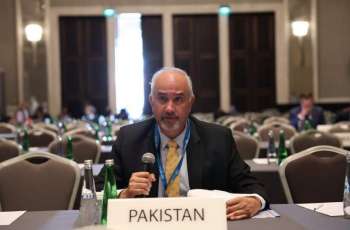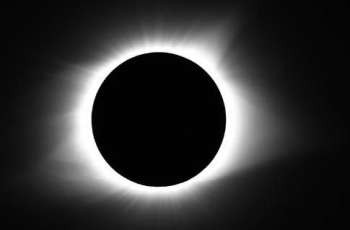This October marks 26 years since the confrontation between the Russian parliament and the president turned into an armed clash in Moscow
MOSCOW (Pakistan Point News / Sputnik - 03rd October, 2019) This October marks 26 years since the confrontation between the Russian parliament and the president turned into an armed clash in Moscow.On October 3, 1993, the confrontation between the two branches of Russian power the executive, represented by then-President Boris Yeltsin and the legislative, represented by parliament, the Supreme Soviet, headed by Ruslan Khasbulatov around the pace of reforms and methods of building a new state, culminated into an armed conflict and ended with tanks shelling of the parliament building known as the White House.
According to the conclusion of the State Duma's the new parliament commission that analyzed the events, which took place in Moscow from September 21 to October 5, 1993, the preparation and publication of Yeltsin's historical decree No. 1400, issued on September 21, 1993, sparked a showdown between the presidency and parliament.
The decree on the implementation of constitutional reforms ordered the dissolution of the country's legislature and the creation of a completely new legislative body a bicameral parliament.
On September 21, 1993, at about 8 p.m., Yeltsin promulgated the decree in a televised address to citizens, saying that it was impossible to continue cooperation with the legislative branch because the Supreme Soviet became the "headquarters of the intransigent opposition," which "pushes Russia over the edge." He set elections for the new parliament for December 11-12, 1993.
Khasbulatov appeared on television 30 minutes after the president's address. He called Yeltsin's actions a "coup d'etat." An emergency meeting, where the presidium of the Supreme Soviet adopted a resolution proving the automatic impeachment of the president, was held at about 10 p.m.
On the same day, the Russian Constitutional Court held an extraordinary hearing, chaired by Valery Zorkin. The court concluded that the presidential decree was inconsistent with the country's constitution and established grounds for the president's impeachment.
After the court's conclusion was delivered to the Supreme Soviet, it continued the meeting and passed a resolution appointing the vice-president, Alexander Rutskoy, as acting president and scheduling an emergency session for September 22, 1993.
The country plunged into an acute political crisis.
The emergency session on September 22 started at midnight and lasted for 19 hours. The Supreme Soviet adopted a resolution to terminate Yeltsin's powers as president and to delegate them to Rutskoy.
About 1,500 people gathered at the White House by 10 a.m. on September 22. The number of the Supreme Soviet's supporters grew by the hour, and by the afternoon, several thousand people had assembled.
The White House's telephone line, and later the electricity, was shut off. In order to ensure the security of the parliament building, citizens began to form volunteer units.
On September 28, 1993, the parliament building was completely blocked by additional police and interior ministry forces. The military and police officers were equipped with bulletproof vests, helmets, shields and batons. Some units were armed with light automatic weapons.
The streets adjacent to the White House were blocked by barriers, and people and vehicles were not allowed to enter the sealed-off area.
Citizens supporting the Supreme Soviet started gathering near the police cordon at 8 a.m. Their number, as well as tensions, increased gradually. Attempts by people's deputies and citizens to secure access to the parliament building were suppressed by police officers.
Zorkin issued a demand for federal authorities and authorities of the Russian constituent entities, in which he outlined his vision of a "zero option" for overcoming the constitutional crisis. In particular, he proposed suspending the execution of all the president's and parliament's acts that were adopted since 8 p.m. on September 21, 1993, including the decree No. 1400 and the Supreme Soviet's decision on Yeltsin's removal from office.
Representatives of the Supreme Soviet and the president met for negotiations on the night of October 1. Parliament was represented by the chairman of the presidium, Veniamin Sokolov, and chairman of the Council of Nationalities, Ramazan Abdulatipov. The other side was represented by the head of the presidential administration, Sergey Filatov; Moscow Mayor Yuri Luzhkov; and Oleg Soskovets, first deputy prime minister.
As a result of the negotiations, the parties signed protocol No. 1, which provided for the collection and containment of weapons in the parliament building, as well as the reduction of forces and means of external security in front of the building.
In response, the "presidential side" agreed to immediately turn on the telephone line, electricity and heat supply.
Eventually, the lights and heat in the White House were turned on. However, at 6 a.m. the Defense Council decided that the agreement signed with Yeltsin's representatives was a mistake. The actions of Sokolov and Abdulatipov were interpreted as an abuse of authority, and protocol No. 1 was canceled. After this decision, the electricity in the parliament building was turned off again, and four columns of armored vehicles raced to the building.
New negotiations, with the Russian Orthodox Patriarch acting as a mediator, began at 10:30 a.m.
On October 2, supporters of the Supreme Soviet held a rally on Smolenskaya Square in Moscow, which ended in clashes between the demonstrators, and the police and special police forces.
On October 3, the conflict became an avalanche. The opposition rally, which began at 2 p.m. in the center of Moscow, gathered tens of thousands of people. After breaking through the special police forces, the rally participants moved toward the White House.
The demonstrators stormed several floors of the nearby city hall building, while police officers used firearms against those who were charging the cordon.
An assault on the Ostankino television center began at around 7 p.m. The broadcasts on the first and fourth television channels were halted. After a short break, the second channel went back on the air from a backup studio. The attempt to take the television center was unsuccessful.
Yeltsin signed a decree declaring a week-long state of emergency in Moscow beginning at 4 p.m. on October 3.
Troops were then deployed in Moscow.
On October 4, the operation to free the White House began. Tanks fired on the upper floors of the parliament building, and the explosions of tank shells caused destruction and a fire inside.
At around 10:30 a.m. Rutskoy requested negotiations with Yeltsin, but the latter refused to talk and demanded "complete surrender."
At about 3:30 p.m. people's deputies who were in the White House decided to end the resistance and leave the building under the security assurances provided by the Alpha and Vympel special forces.
According to the conclusions of the State Duma Commission, about 200 people were killed and at least 1,000 others injured during the events that took place from September 21 to October 5, 1993.
As a result of the tragic events, the Congress of People's Deputies and the Supreme Soviet were liquidated. The direct presidential rule was established in Russia prior to the election of the Federal Assembly and the adoption of the new Constitution.
Yeltsin also issued a series of decrees terminating the activities of representative bodies of the country's constituent entities.
The new Constitution was adopted on December 12, 1993.
On February 23, 1994, the State Duma announced political and economic amnesty for those who participated in the events of September-October 1993.




